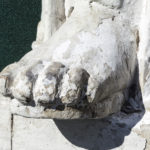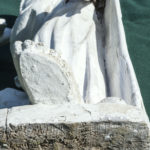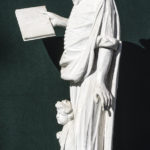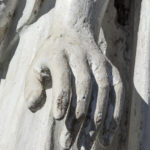Details of the Retable of Hageri church

There is certainly no doubt that Ackermann carved the putto cantilevers with his own hands, but the master evidently used the assistance of one of his helpers in carving the statues of Matthew and Mark. The statues of Matthew and Mark admittedly follow the characteristic contours of Ackermann’s sculptures right down to their details, but a sort of peculiar dullness and superficiality characterises them. It hardly seems likely that Ackermann would have left the heel that extends out beyond the edge of the figure’s base (pedestal) uncarved from below in its true anatomical form, as is the case with both the evangelists Matthew and Mark.
A comparison of Matthew’s two hands also supports the assumption that one of the master’s assistants helped to complete the statue: Matthew’s angular hand holding the book clearly differs from his other hand, which is streamlined and finely carved. Such a different style, and the fact that the finely carved hand’s dimensions are too large in relation to the figure, lead to the idea that Matthew’s beautiful hand had originally been meant for a different statue, presumably a woman’s figure: as a rule, the wish to adhere to men’s anatomy and to model muscles and swollen blood vessels is noticeable in the case of the hands of Ackermann’s male figures.
- Foto: Peeter Säre
- Foto: Peeter Säre
- Foto: Peeter Säre
- Foto: Peeter Säre



